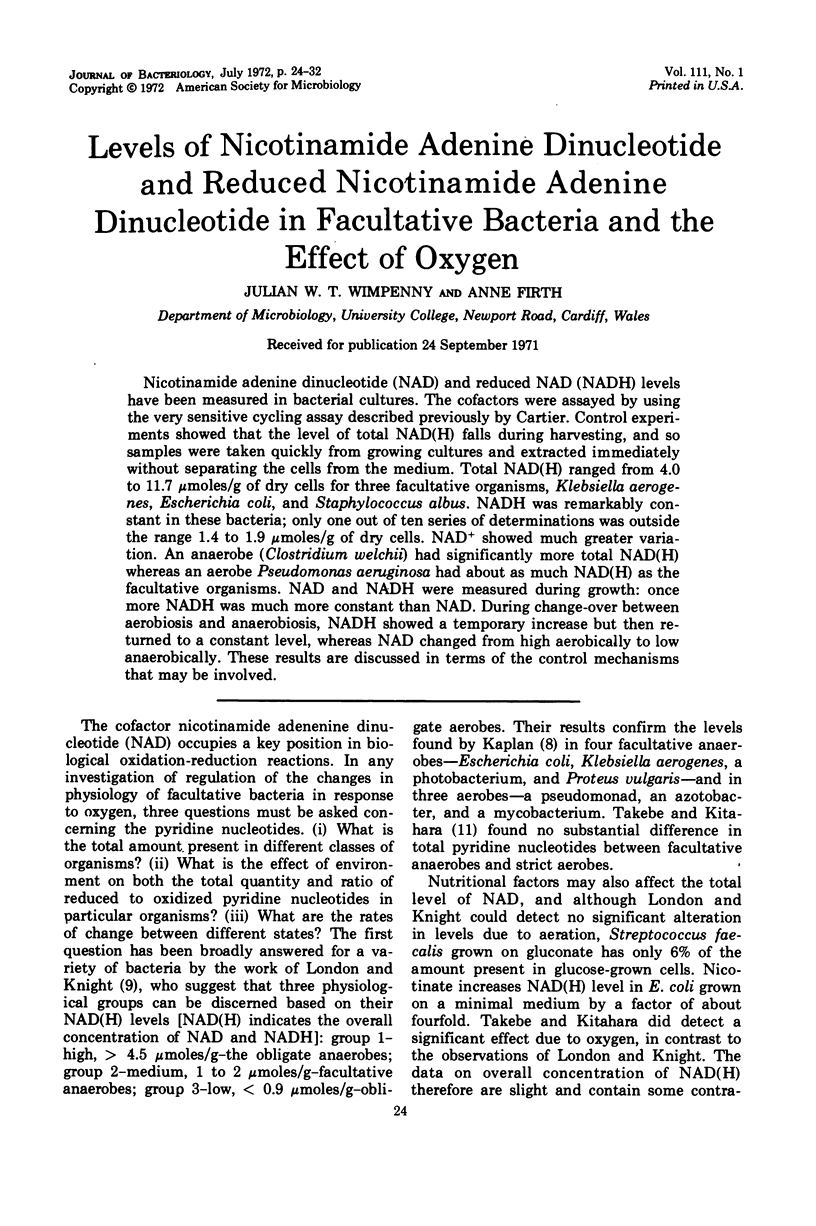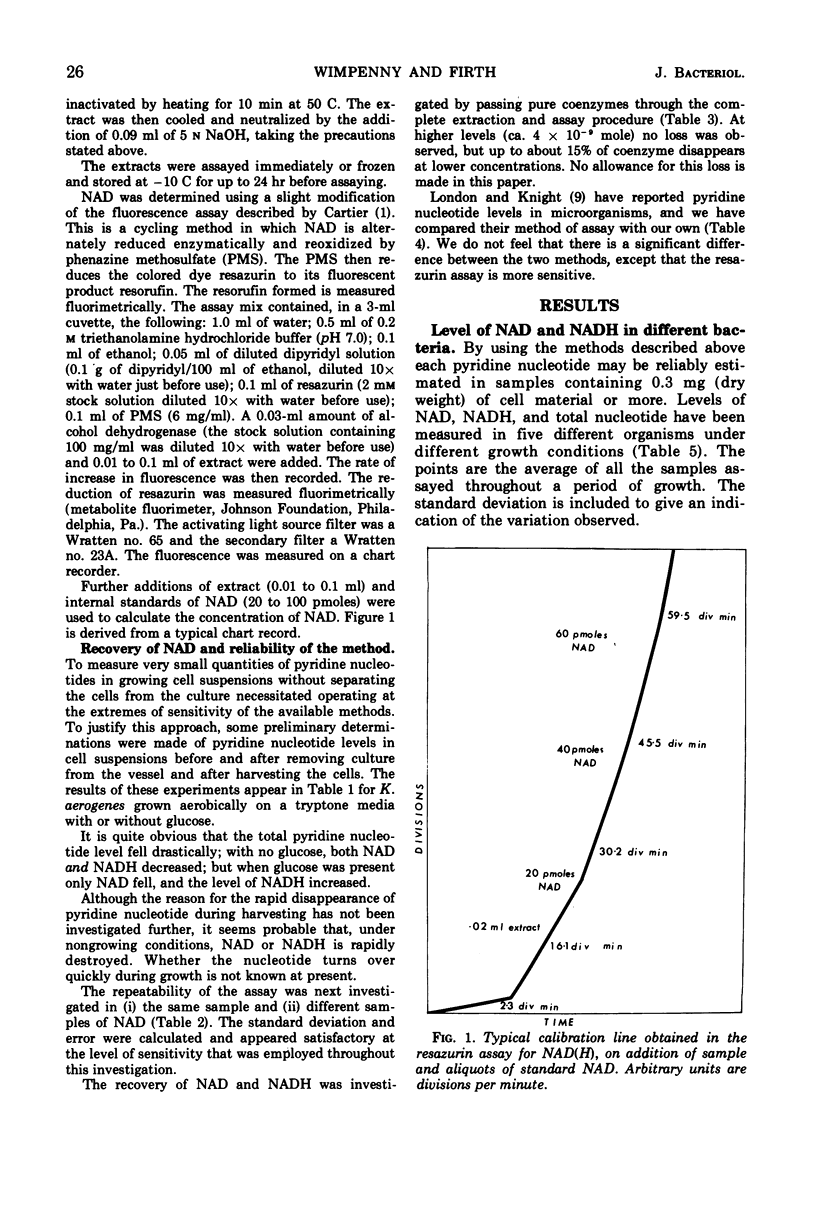Abstract
Nicotinamide adenine dinucleotide (NAD) and reduced NAD (NADH) levels have been measured in bacterial cultures. The cofactors were assayed by using the very sensitive cycling assay described previously by Cartier. Control experiments showed that the level of total NAD(H) falls during harvesting, and so samples were taken quickly from growing cultures and extracted immediately without separating the cells from the medium. Total NAD(H) ranged from 4.0 to 11.7 μmoles/g of dry cells for three facultative organisms, Klebsiella aerogenes, Escherichia coli, and Staphylococcus albus. NADH was remarkably constant in these bacteria; only one out of ten series of determinations was outside the range 1.4 to 1.9 μmoles/g of dry cells. NAD+ showed much greater variation. An anaerobe (Clostridium welchii) had significantly more total NAD(H) whereas an aerobe Pseudomonas aeruginosa had about as much NAD(H) as the facultative organisms. NAD and NADH were measured during growth: once more NADH was much more constant than NAD. During change-over between aerobiosis and anaerobiosis, NADH showed a temporary increase but then returned to a constant level, whereas NAD changed from high aerobically to low anaerobically. These results are discussed in terms of the control mechanisms that may be involved.
Full text
PDF








Selected References
These references are in PubMed. This may not be the complete list of references from this article.
- Cartier P. H. Dosage des pyridine nucléotides oxydés et réduits dans le sang et les tissus animaux. Eur J Biochem. 1968 Apr 3;4(2):247–255. doi: 10.1111/j.1432-1033.1968.tb00201.x. [DOI] [PubMed] [Google Scholar]
- Chance B., Hess B., Betz A. DPNH oscillations in a cell-free extract of S. carlsbergensis. Biochem Biophys Res Commun. 1964 Jun 1;16(2):182–187. doi: 10.1016/0006-291x(64)90358-4. [DOI] [PubMed] [Google Scholar]
- Ghosh A., Chance B. Oscillations of glycolytic intermediates in yeast cells. Biochem Biophys Res Commun. 1964 Jun 1;16(2):174–181. doi: 10.1016/0006-291x(64)90357-2. [DOI] [PubMed] [Google Scholar]
- Gray C. T., Wimpenny J. W., Hughes D. E., Mossman M. R. Regulation of metabolism in facultative bacteria. I. Structural and functional changes in Escherichia coli associated with shifts between the aerobic and anaerobic states. Biochim Biophys Acta. 1966 Mar 28;117(1):22–32. doi: 10.1016/0304-4165(66)90148-6. [DOI] [PubMed] [Google Scholar]
- HOMMES F. A. OSCILLATORY REDUCTIONS OF PYRIDINE NUCLEOTIDES DURING ANAEROBIC GLYCOLYSIS IN BREWERS' YEAST. Arch Biochem Biophys. 1964 Oct;108:36–46. doi: 10.1016/0003-9861(64)90352-2. [DOI] [PubMed] [Google Scholar]
- London J., Knight M. Concentrations of nicotinamide nucleotide coenzymes in micro-organisms. J Gen Microbiol. 1966 Aug;44(2):241–254. doi: 10.1099/00221287-44-2-241. [DOI] [PubMed] [Google Scholar]
- Maitra P. K., Estabrook R. W. Studies of baker's yeast metabolism. II. The role of adenine nucleotides and inorganic phosphate in the control of respiration during alcohol oxidation. Arch Biochem Biophys. 1967 Jul;121(1):129–139. doi: 10.1016/0003-9861(67)90017-3. [DOI] [PubMed] [Google Scholar]
- Williamson D. H., Lund P., Krebs H. A. The redox state of free nicotinamide-adenine dinucleotide in the cytoplasm and mitochondria of rat liver. Biochem J. 1967 May;103(2):514–527. doi: 10.1042/bj1030514. [DOI] [PMC free article] [PubMed] [Google Scholar]
- Wimpenny J. W., Necklen D. K. The redox environment and microbial physiology. I. The transition from anaerobiosis to aerobiosis in continuous cultures of facultative anaerobes. Biochim Biophys Acta. 1971 Dec 7;253(2):352–359. doi: 10.1016/0005-2728(71)90039-9. [DOI] [PubMed] [Google Scholar]


